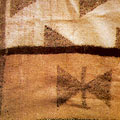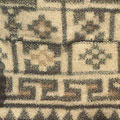The rari, a hardy woollen rug and blanket, has been used throughout Nepal for as long as people can remember. A long established source of income, it is based on the extraordinary skill of the Gurung weavers who very probably brought about the first recorded trade transactions from Nepal – namely, the export of woollen blankets to India in the third century AD. An essential part of every home, it is put to many uses, though its specific, ritually prescribed use is limited to periods of birth and mourning. It is an important part of the dowry. Rari weaving has its roots in antiquity and it is the best known of all woollen woven items. Its weaving is so common and widespread in Nepal that it is practised in most villages in the high and mid-hill regions.
TRADITIONS
Though woven all over Nepal, the rari has been associated with the Gurungs for centuries. It is believed that the finest quality rari is made in Rumjatar in east Nepal, where it is a cottage industry. Used to sit or sleep on or as a rug, the small, fringed sleeping-mat (burkasan) is about 70 cm X 150 cm in size; larger raris are made up from two or more panels joined at the selvedge.
Traditionally, it is the women who prepare the yarn and weave the rari in their leisure hours, when their agricultural and household duties are done; the men do the final finishing and felting, or help with the warping or the heavy wool embroidery which is applied after weaving. It is the man’s job to sell raris that are woven for sale – it is a common sight to see men carrying three or four raris of different sizes on their shoulders at markets and village bazaars while they look for buyers. The rari is priced much lower than the Tibetan woollen carpets and there is a huge demand for them in the winter months. The weaving is therefore timed for the summer and the selling in the chilly months of winter.
The rari not only serves the purpose of pallet but is also used for a number of other purposes. A high quality rari can be converted into a warm overcoat (bakkhu) or into warm vests, scarves, and bags. Rari weavers have made modifications in sizes and patterns to capture changing requirements and are also weaving small-sized pieces with coloured designs on them. The traditional rari, however, is still a valuable trade item even today at village markets as well as in the streets of Kathmandu.

RAW MATERIALS
The local baruwarl sheep is the main and most sought after source of raw material for rari weaving, though other varieties of local wool are also used. The fleece of the baruwarl is short and rather hard. Garments are woven mainly from the soft wool of the first and second shearing, and raris from later shearing. The different shades of the baruwal fleece – ranging from white, to beige and brown, and black – are used by the weavers in patterning. Tapestry-type patterned blankets are also sometimes dyed with ochre, obtained from walnut shell, and light red from madder.
The main varieties of baruwala wool include:
- Garve wool – that is obtained from a lamb whose wool has never been sheared – this wool is obtained as a first crop and is therefore very soft, fine, and of high quality.
- Chharve wool – a variety that is obtained as a second or third crop of the baruwala and is less soft and of medium quality.
- Torbe wool – the third variety of the baruwala is obtained as a third or forth crop. It is usually rough and of low quality.
Garve and Chharve wool are not normally used while weaving the rari as they are used in making outer clothing like coats and other items. The rough torbe wool is the preferred variety. The colours of the wool range from white, to black, and grey, and shades in between; the black wool is the most expensive.
Wool is also obtained from different varieties of locally available sheep: the wool of the chyangra is used. Two grades of wool are obtained from the chyangra. The portion of the wool, about an inch long, near the skin of the animal is of a high quality is used in weaving mufflers and shawls – it is very soft, of high quality, and very expensive. The end portion of the wool is rough and is used in the making of the rari.
Wool obtained from local kage ram is also used though, it is not the first choice of the weaver. A rari made only of the wool o the kage is very rough and even a slight jerk or rub causes the wool to shred off the rari.

PROCESS & TECHNIQUE
The wool is carefully sheared using a chupi (knife); as a large quantity of wool is required the rari maker often needs to go to other villages to fulfil the requirement of wool. The quality of wool thus collected is therefore of different grades.
The wool is then washed, dried, matted, and heaped together in a big entangled mass. It is then shredded into soft fluffy fur. This is done with a special instrument that is shaped like a large wooden bow linked with a fine skin rope (dhanu). The people of the Terai are experts in its usage and they travel from village to village with their triangular dhanu on their shoulder. The dhanu carrier is an expert – in a short time he can break up two or three dharnis of lumpy cotton or wool into fluff. He hits the string of the skin rope with a wooden handle, and the vibrating string continuously hits the lump of wool or cotton, breaking it apart instantly.
The spinning wheel or charkha made of wood is used in preparing yarn out of raw wool or cotton by rotating the spindle; it is then wound on the pin of the wheel.
The yarn (tan) is then stretched in parallel positions on the loom on which the actual weaving is done. The main components of the loom are similar across the board, but some Gurung weavers in east Nepal use cross-sticks rather than the coil-rod warp separator, and the warp is laid without the warp lock-stick.
When the weaving is complete, it is taken off the loom; the un-woven warp threads (12-20 cm long) at the end or between the panels are looped around each other to form a secure border with warp fringes when the circular warp is cut. The cloth panels are then ready for finishing, joining, or tailoring; however, there is still some work to be done on the raris before they undergo their more unusual finishing/felting process. The burkasans used for sleeping, are usually woven full width and need no joining; where they have fringes all the way round, these are added at this stage. Woollen, two-ply yarn strands (15-20 cm long) are knotted into both the selvage sides with lark’s head knots. Larger raris are joined at the selvage to form a complete pattern. Before the stitching a lot of pulling and stretching often has to be done so that the pattern will actually meet.
For the highly valued double blanket/rug, two single raris of the same size but with different patterns are placed one on top of the other and joined by knotting the fringes through both layers of selvages. The two blankets will adhere completely during the felting process, giving the impression of a single piece of weaving and concealing how this rug with two completely different sides was woven.
The quality of the rari, including its ability to withstand wind and water, depends, to some extent, on the finishing/ felting process, which might take a whole day. The rari is then dipped in lukewarm or cold water and rubbed vigorously on a large flat stone slab or wooden plank, preferably by trampling. The more the rari is rubbed, the thicker it becomes – as the stamping operation is tedious and difficult, it is usually done by the men. This process is repeated three times. The felter, supported by two long bamboo sticks, shifts his weight from one foot to the other during this process of felting. This causes the thin net-like structure of the rari to disappear, giving the product a uniform smoothness and thickness. Raris shrink considerably during felting and through the matting of the yarn fibres the texture becomes so close that sometimes one cannot recognise it as weaving.


